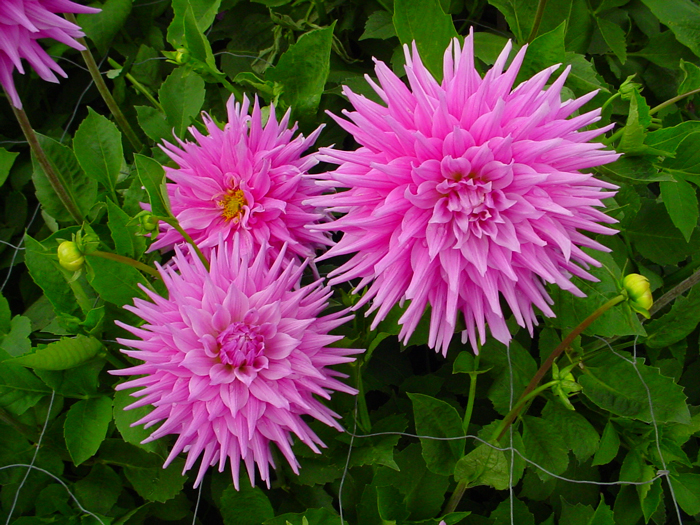November garden diary
Welcome to the November edition of our Garden Diary, written for us by Geoff Hodge, of The ScottsMiracle-Gro Company. Keep up-to-date with what needs doing in your garden with our month by month column.
Indications are that this November the weather is going to be drier than usual with temperatures near to average. This means that, as long as you wrap up warm, there should be plenty of great opportunities for tidying up, planting and generally getting the garden ready for winter. If you need to keep warm, then get on with some gentle digging – but don’t overdo it or you could end up with a bad back!
FLOWER BEDS & BORDERS
Once the first frosts have blackened dahlia foliage, it’s time to lift and store the tubers. If you live in a mild area, the tubers can be left in the ground, covering the soil with a 10-15cm (4-6in) thick mulch of Miracle-Gro Moisture Control Decorative Pine Bark or Levington Water Saving Decorative Bark. But they may succumb to severe winter weather, or come into flower late next year. Take the risk if you want to, but it’s generally safer to lift them.
First cut down the stems to about 15cm (6in) from soil level. Then carefully lift the tubers with a garden fork so as not to damage them. Clean them with water to remove the soil. Don’t forget to label them by tying a label around the stem. Stand the tubers upside down in a dry, airy, frost-free place for a few days to drain excess moisture from the stems. Then pack them in boxes filled with just-moist compost, coir, sand or similar. Make sure the packing material is kept clear of the crown (where the stems join the tuber) or rots may set in. Keep the boxes in a cool, frost-free place over winter.
Cannas can be treated in the same way.
Topical tip
As it’s fairly quiet outside in the garden, you can make the most of your time by drawing up plans for which flowers you want to grow next year. It pays to order your seeds now, so you don’t miss out in spring.
PATIO GARDENING
The roots of plants growing in containers do not have the protection from cold and frost provided when growing in the soil, and even otherwise hardy plants may become damaged during very cold winters. So protect the roots and the containers by wrapping them in bubble wrap, hessian or, better still, ‘duvets’ made from plastic bags filled with shredded newspaper, polystyrene chips, roofing insulation or similar materials.
If possible, move the containers against a sheltered wall or close to a building to provide extra protection.
Also, raise the containers onto pot feet or bricks to avoid them sitting in the wet, which can lead to root rotting and cracking of terracotta pots.
Topical tip
Check plants in containers regularly to ensure the compost doesn’t dry out. Don’t be fooled – even after a period of rain, the compost can still be quite dry.
LAWNS
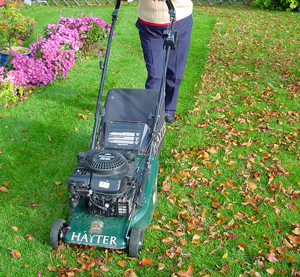 Depending on the weather, the grass may still be growing, so you may need to mow the lawn. Raise the height of cut slightly higher than that for summer, since the grass grows more slowly during autumn. Mowing when the grass needs it will help the lawn to withstand the last of any warm, dry weather and help resist treading when the cold and wet weather arrives. But don’t mow when the grass is wet or frozen.
Depending on the weather, the grass may still be growing, so you may need to mow the lawn. Raise the height of cut slightly higher than that for summer, since the grass grows more slowly during autumn. Mowing when the grass needs it will help the lawn to withstand the last of any warm, dry weather and help resist treading when the cold and wet weather arrives. But don’t mow when the grass is wet or frozen.
Remove fallen leaves off the lawn before they block out light and air penetration to the grass, which can cause the grass to die. On large lawns, a powered leaf collector will make the job much easier or remove them using the lawnmower with the blades set at their highest cutting height. This will make it easier than raking and will chop them into smaller pieces that can then be added to the compost heap.
If you haven’t yet got around to feeding the lawn with an autumn lawn food, it can still be done in November. EverGreen Autumn 2in1 also contains ferrous sulphate to control moss. For full details on autumn lawn care, visit LoveTheGarden.com – www.lovethegarden.com/lawncare/autumn-lawn-care
Topical tip
Individual toadstools on the lawn are usually harmless to the grass, but are best removed if small children are present. Sweep them away before the caps open and spread their spores.
GROW YOUR OWN
Vegetables
There’s still time to sow an overwintering broad bean, such as ‘Aquadulce Claudia’, for an early crop next year. Cover the soil and developing young plants with fleece or, better still, cloches to provide protection from cold, frost and pigeons.
It may be better to sow them in small pots or cell trays and then plant out the young plants when they’ve grown on.
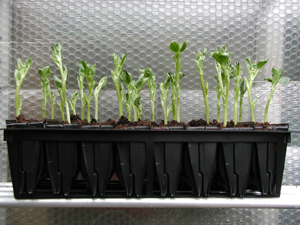 Radishes, mustard, cress, cut-and-come-again salad leaves and winter lettuces can be sown in Miracle-Gro Gro Your Own Vegetable & Fruit Giant Planters in a greenhouse or in pots of Miracle-Gro Gro Your Own Vegetable & Fruit Enriched Compost kept on a light windowsill or in a conservatory.
Radishes, mustard, cress, cut-and-come-again salad leaves and winter lettuces can be sown in Miracle-Gro Gro Your Own Vegetable & Fruit Giant Planters in a greenhouse or in pots of Miracle-Gro Gro Your Own Vegetable & Fruit Enriched Compost kept on a light windowsill or in a conservatory.
This is a good time to get ahead and prepare new asparagus beds for planting in the spring. Plenty of added organic matter and even grit will help to improve drainage on heavy, clay soils – vital for good crops.
November is the best month to plant garlic, but make sure it is a variety suitable for autumn planting.
Topical tip
Make your sowing plans and order your vegetable seeds now. When the seeds arrive, you could make a seed organiser, divided into sowing months to help you remember to sow at the right time.
Fruit
Now’s the perfect time to plant all new fruit trees, bushes and canes. The soil will still be quite warm, and the roots of new plants will benefit from this. This is particularly important for peaches and nectarines. Make sure the soil is well prepared with plenty of organic matter – such as Levington Organic Blend Soil Conditioner, Levington Organic Blend Farmyard Manure or Levington Rose, Tree & Shrub Compost. Mix in more organic matter plus Miracle-Gro Bone Meal Natural Root Builder with the soil dug out from the planting hole.
Always plant at the same depth that the plant was originally growing, firm the soil around the roots and water in well.
Trees will need to be staked with a good tree stake and secured with two tree ties. After planting, mulch the soil around fruit trees and bushes with a 5-7.5cm (2-3in) thick layer of Levington Water Saving Decorative Bark or Miracle-Gro Moisture Control Decorative Pine Bark to help keep weeds down and maintain soil moisture levels in spring and summer.
You can prune red and white currants and gooseberries by cutting back main branches by half to three-quarters and sideshoots to one to three buds from their base.
Topical tip
Rabbits, deer and squirrels can be a problem at this time of year, gnawing the bark of fruit trees. Protect trees by wrapping their stems in plastic tree protectors.
TREES, SHRUBS, ROSES & CLIMBERS
Hardwood cuttings are the easiest way to propagate a wide range of shrubs, including roses, dogwoods (Cornus), mock orange (Philadelphus), flowering currant (Ribes) and Forsythia. You can also use this method for a range of soft fruit, including blueberries, currants and gooseberries; only use healthy, virus-free plants.
Remove strong, healthy shoots about 23-30cm (9-12in) long. Trim the base just below a bud and trim the top to just above a bud, removing the soft growing tip. Treat the bottom cut with hormone rooting powder or liquid. Insert the cuttings to half to two-thirds their height in a V-shaped trench, lined with 2.5cm (1in) of sharp sand or grit. Make the trench by inserting a spade into the ground and then pushing it forward. Replace the soil, firming it around the cuttings and water in. The cuttings will have rooted and be ready to plant out next autumn.
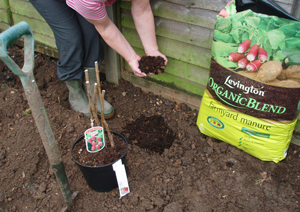 You can protect the roots of penstemons, phygelius, hardy fuchsias and other slightly tender plants from damaging winter frosts by covering the soil around them with a 7.5-10cm (3-4in) deep layer of Levington Water Saving Decorative Bark or Miracle-Gro Moisture Control Decorative Pine Bark. Don’t cut down the old stems until spring, as this can provide some extra frost protection of growth buds low down on the stems.
You can protect the roots of penstemons, phygelius, hardy fuchsias and other slightly tender plants from damaging winter frosts by covering the soil around them with a 7.5-10cm (3-4in) deep layer of Levington Water Saving Decorative Bark or Miracle-Gro Moisture Control Decorative Pine Bark. Don’t cut down the old stems until spring, as this can provide some extra frost protection of growth buds low down on the stems.
November is the perfect month for moving deciduous small trees, shrubs and climbers that are growing in the wrong place or have outgrown their space. Older plants may not establish well, and so may not be worth the risk.
Where possible, start by pruning back up to half of the top growth – moving plants puts a stress on the plants and you can reduce this stress by reducing the amount of stems and leaves the plant has.
Water the soil around the plant thoroughly the day before. Dig up as big a rootball as possible that you or you and a friend can manage to lift.
Replant in well-prepared soil with lots of added Levington Organic Blend Soil Conditioner, Levington Organic Blend Farmyard Manure or Levington Rose, Tree & Shrub Compost plus Miracle-Gro Bone Meal Natural Root Builder, so that the rootball sits at the same level as it was originally, covered with no more than an inch or so of soil. Tall shrubs and trees may need staking to keep the roots secure. Water in well after moving and for the first year.
Topical tip
Check tree stakes and ties are secure and will withstand strong winter winds. At the same time, ensure ties are not strangling trunks or branches and slightly loosen them if they are.
GENERAL GARDENING JOBS
Clear away all fallen leaves promptly, as rotting leaves can be a source of disease and a home for pests. They can also smother small plants and cause areas of the lawn to die.
They can be added to the compost heap (Miracle-Gro Compost Maker will aid faster rotting down), and even shredded first by going over them with a lawnmower to help them break down quicker. Another option is to make them into leafmould. Simply collect up the leaves and put them in a hessian leafmould sack or plastic bag (such as a bin liner). Moisten the leaves if dry to help them rot, pierce the bag to make a number of holes, tie the top loosely and then simply hide them around the garden and leave for a year or two.
Patio slabs, paths and wooden decking can become extremely slippery and dangerous during wet weather. Treating them with Patio Magic! will remove slippery algae as well as moss and lichens to reduce the risk, as well as making them look far more attractive.
It’s time to get your greenhouse and cold frames ready for the onset of cold, winter weather. Insulating them with bubblewrap will help to keep vital warmth inside. Cold frames can also be insulated with hessian or polystyrene sheets – but remember to remove it during the day to allow in light to the plants.
Topical tip
Consider installing water butts and water-collection systems in the garden to make the most of all the late autumn and winter rain. If you already have water butts, then give them a good cleaning out to help keep the water fresh.
HOUSEPLANTS
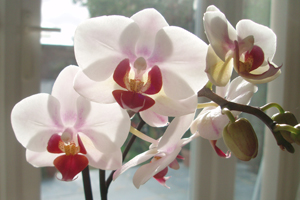 Autumn and winter can be stressful times for houseplants, so give them the care they need to keep them strong and healthy.
Autumn and winter can be stressful times for houseplants, so give them the care they need to keep them strong and healthy.
Regularly pick off yellowing or dead leaves and faded flowers to keep plants looking their best and help prevent disease problems developing and spreading.
Check houseplants for greenfly and other pests as they can multiply quickly now that the central heating is on. Either rub them off or spray them with BugClear Ultra Gun!.
Be careful not to overwater – the biggest killer of most houseplants – and never leave water sitting in plant saucers as this can cause root rotting. Water cyclamen by filling the saucer with water until the plant takes up no more – then throw away any surplus. Watering from the top may rot the tuber.
There’s no need to feed foliage houseplants now. Flowering houseplants will give a better display for longer if fed weekly with a liquid houseplant fertiliser, such as Miracle-Gro Pour & Feed.
Cacti and succulents, apart from Christmas cacti, need a period of cool dormancy over the winter; keep them at 7-13C (45-55F), the compost barely moist and don’t feed them. Resume normal care next spring to bring them back into growth and flowering. Clivias also benefit from a rest period over winter.
Give foliage houseplants a break from the dull winter indoor light by moving them nearer to windows or to a conservatory.
Topical tip
Always water houseplants with tepid water, especially during autumn and winter. Using cold water can shock the roots, causing overall stress to the plant.
Use plant protection products & biocides safely. Always read the label and product information before use.
BugClear™ Ultra Gun! contains acetamiprid.
Products marked ® and ™, Miracle-Gro® and Levington® are trademarks of The Scotts Company LLC or its subsidiaries.
All images are © of: The Scotts Miracle-Gro Company
Salisbury House, Catteshall Lane, Godalming, Surrey GU7 1XE.
For further information and news, visit lovethegarden.com

